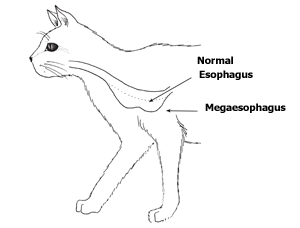The esophagus is a part of the gastro-intestinal tract
that is extremely important for eating. It is the tube that gets the food down
into the stomach. There are many reflexes, muscles and nerves that coordinate
to ensure food goes down the esophagus and does not end up in the trachea and
then into the respiratory system. If there are any disease processes that alter
the structure of the esophagus it could lead to issues with digestion.
 |
| The dotted line shows where a normal esophagus would lay vs a megaesophagus (Image Source) |
Megaesophagus is typically a condition that is secondary
to something else. Once the esophagus becomes flaccid or loses its tone, we
will begin to see symptoms of megaesophagus. These symptoms can include regurgitation
and coughing, chocking whenever the patient is eating. There may also be
symptoms associated with whatever the underlying cause of the megaesophagus is.
It is important to not the regurgitation is different from vomiting.
Regurgitation is passive, the food can sit in the esophagus and then just come
back out of the mouth. Vomiting is active where the body is forcefully expelling
the food or item. It can include gagging, muscle contraction and is typically
very noisy. To confirm a diagnosis of megaesophagus, x-rays are required. This
can show an enlargement of the esophagus in the chest cavity.
Treatment will include determining the underlying cause
and deciding if this can be fixed or managed. After that, the megaesophagus can
then be managed as well. This will include using gravity to help move food from
esophagus to the stomach. In addition to the elevated feeding, many times
making the food into a meat ball consistency, works for the majority of cases.
However sometimes it requires trial and error may be required to find what
works for your pet. There are some medications that can be added that may help
control the regurgitation as well. It is important to see if the underlying
condition can be managed, to reduce the risk of worsening the megaesophagus.
 |
| There are many different methods of elevated feedings. You will have to find the one that works best for you and your pet! (Image Source) |
For more information on this condition please visit the following
website
here.


No comments:
Post a Comment